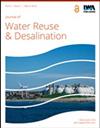使用疏水/亲水双层膜的直接接触膜蒸馏的性能建模
IF 2.3
Q2 Environmental Science
引用次数: 2
摘要
采用HFP-co-PVDF/N6疏水/亲水双层膜对直接接触膜蒸馏脱盐进行了研究。提出了一个一维(1-D)模型来预测通量和热效率。对亲水层和疏水层的传热传质方程进行了数值求解。在计算传质系数时考虑了疏水层的膜特性,而亲水层则被忽略,因为假设它充满了水。然而,在计算传导传热时,亲水层被考虑在内。因此,与单层疏水膜相比,方程是不同的。研究发现,在相同的疏水膜特性下,单层膜比双层膜具有更好的通量和热效率。此外,还没有通过实验观察到通过添加亲水层来提高通量和热效率,并且表明先前报道的双层膜的性能的提高是由于通过使用更薄和更多孔的疏水层来提高渗透性,该疏水层可以由亲水层机械增强。通过将单层和双层膜的实验结果与建模结果进行比较,对模型进行了验证。模型预测的通量和热效率与实验结果的误差在10%以内。本文章由计算机程序翻译,如有差异,请以英文原文为准。
Performance modelling of direct contact membrane distillation using a hydrophobic/hydrophilic dual-layer membrane
HFP-co-PVDF/N6 hydrophobic/hydrophilic dual-layer membrane was used to study desalination with direct contact membrane distillation (DCMD). A one-dimensional (1-D) model was proposed to predict the flux and thermal efficiency. Heat and mass transfer equations were solved numerically for the combined hydrophilic and hydrophobic layers. The membrane characteristics of the hydrophobic layer were considered for the calculation of the mass transfer coefficients, while the hydrophilic layer was ignored since it was assumed to be filled with water. However, the hydrophilic layer was taken into account during the calculations of conductive heat transfer. Therefore, the equations are different, compared to single-layer hydrophobic membranes. It was found that with the same hydrophobic membrane characteristics, the single-layer membranes performed with better flux and thermal efficiency than the dual-layer membranes. Furthermore, the improvement of flux and thermal efficiency by an addition of the hydrophilic layer has not been observed experimentally, and it is suggested that the improved performance for dual-layer membranes reported previously is due to improved permeability by using thinner and more porous hydrophobic layers that can be mechanically reinforced by the hydrophilic layer. The validation of the model was conducted by comparing the experimental results for single- and dual-layer membranes with the modelling results. The predicted flux and thermal efficiency by the modelling were within 10% error to the experimental results.
求助全文
通过发布文献求助,成功后即可免费获取论文全文。
去求助
来源期刊

Journal of Water Reuse and Desalination
ENGINEERING, ENVIRONMENTAL-WATER RESOURCES
CiteScore
4.30
自引率
0.00%
发文量
23
审稿时长
16 weeks
期刊介绍:
Journal of Water Reuse and Desalination publishes refereed review articles, theoretical and experimental research papers, new findings and issues of unplanned and planned reuse. The journal welcomes contributions from developing and developed countries.
 求助内容:
求助内容: 应助结果提醒方式:
应助结果提醒方式:


